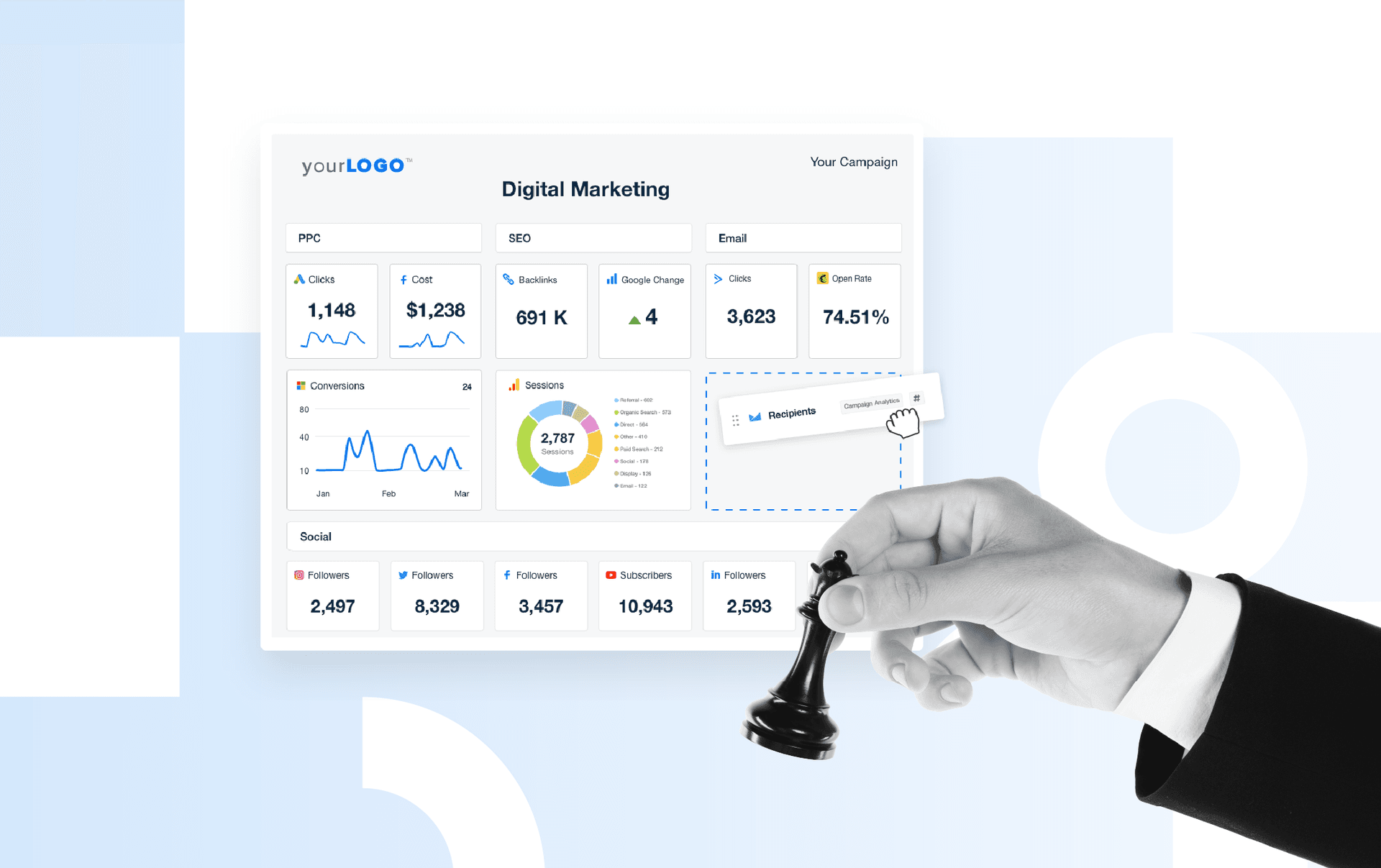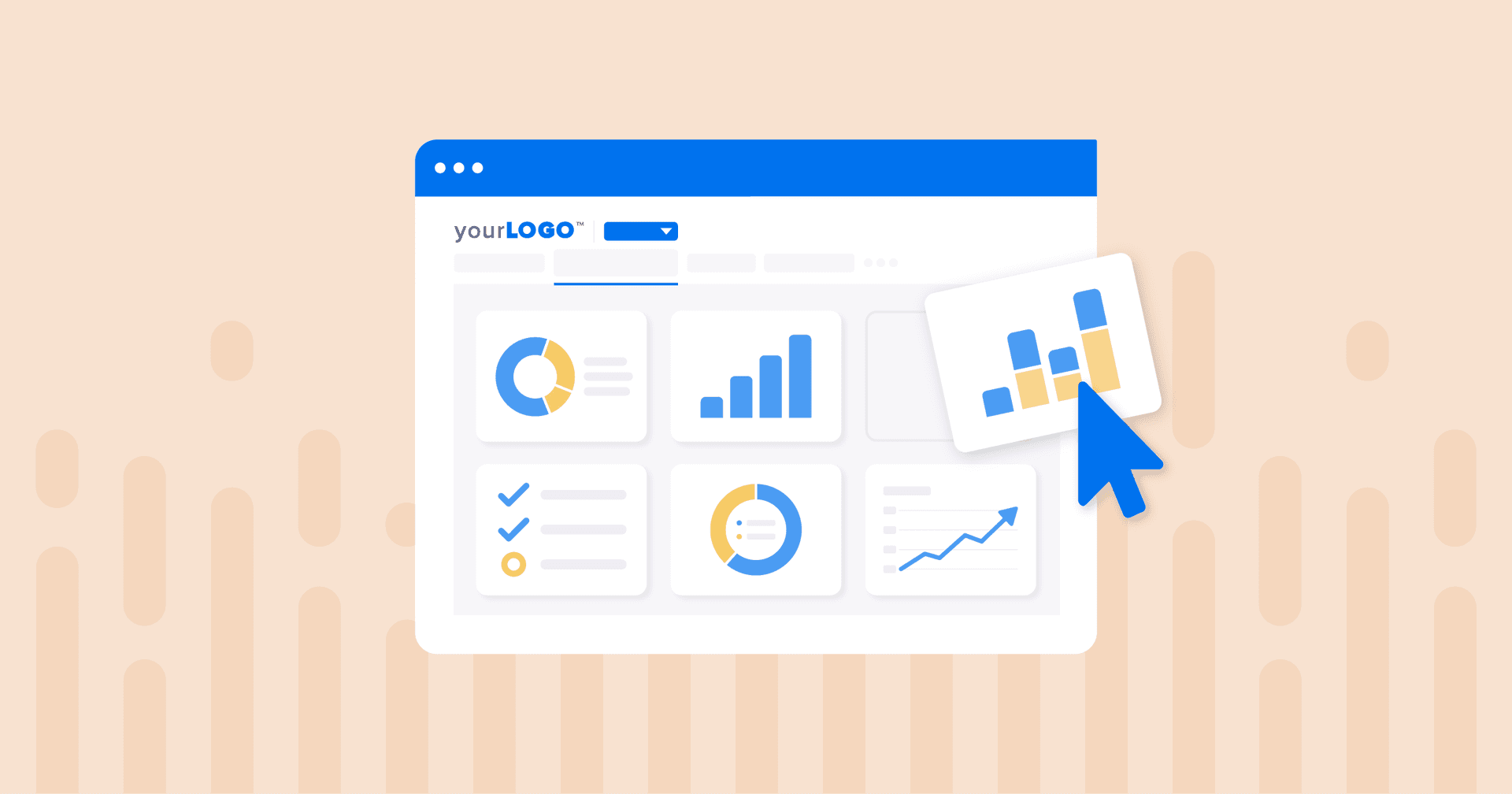Table of Contents
Table of Contents
- What is a client marketing dashboard?
- Why client dashboards matter for agencies
- Key features of effective marketing dashboards
- Step-by-step guide to building a client dashboard
- Best practices for dashboard design and implementation
- Common mistakes to avoid
- Smarter dashboards, stronger client relationships
7,000+ agencies have ditched manual reports. You can too.
Free 14-Day TrialQUICK SUMMARY:
Have you ever wondered how to build client marketing dashboards that transform complex data into clear reporting on essential metrics? You’ve come to the right place. In this article, we’ll cover why marketing agencies should focus on dashboard creation, how tracking the right metrics enables marketers to optimize performance, key features to include, and step-by-step instructions to create your own dashboards for clients.
Communication is essential to the agency-client relationship. Keeping your clients looped into the progress of their digital marketing campaigns underscores the value your agency is bringing to the table, and provides context and rationale for the next steps you suggest.
Client marketing dashboards make it easy for clients to log in whenever they please and watch how things are unfolding. How’s that latest Google Ads campaign influencing click-through rate? Is that local SEO push driving traffic? A client marketing dashboard presents all the information clients need, in a clear and visually appealing manner, eliminating the guesswork and underscoring all the amazing deliverables your agency is executing on their behalf.
That said, not all client marketing dashboards are created equal. How you build the dashboard influences how your clients will digest the information, so the elements you choose to include matter… a lot.
In this article, we’re sharing exactly how to build a client dashboard that proves your agency’s ROI and keeps the communication rolling between your agency and your clients.
What is a client marketing dashboard?
A client marketing dashboard is a customized tool that brings together data from different platforms–like Google Analytics, social media, and ad accounts–into one clear, easy-to-understand view. Instead of sending clients multiple reports or spreadsheets, you provide them with a single place where they can see how their marketing is performing.
For example, your client wants to know if their latest ad campaign is driving more website visits. Instead of sending them a detailed spreadsheet with dozens of numbers, the dashboard shows a simple graph of website traffic trends alongside key metrics like clicks and conversions. This helps clients quickly see if things are improving or if adjustments might be needed.
You can also control what each client sees by setting permissions so they get relevant information without accessing sensitive data. Once the dashboard is ready, just share the link, and clients can access their data and track performance metrics in real-time without waiting for reports.
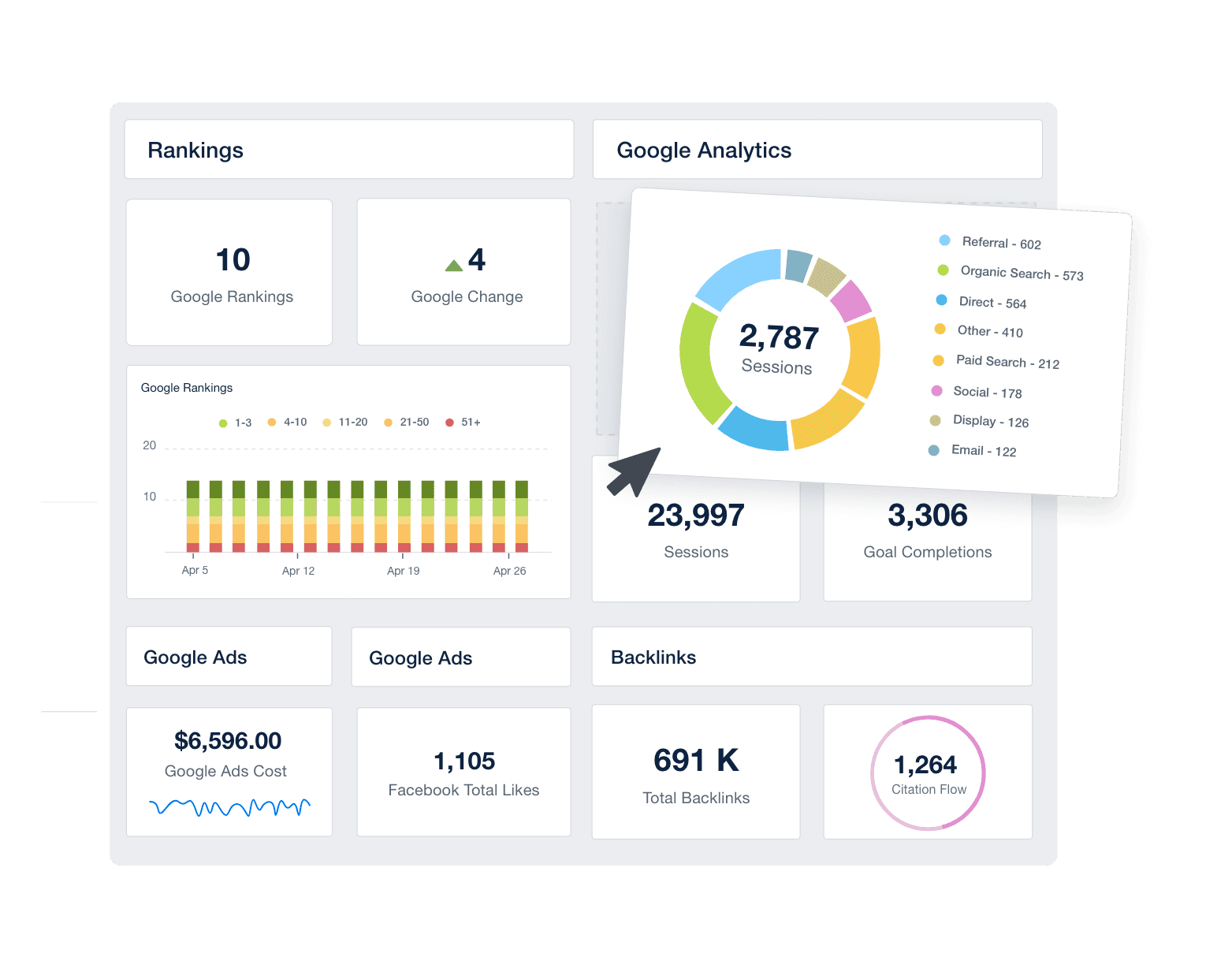
Why client dashboards matter for agencies
A great reporting dashboard does more than just collect data; it tracks key metrics, integrates easily with other tools, provides real-time updates, and is customizable to each client’s needs. Most importantly, it’s easy to use for everyone involved.
Think about the last time you tried to explain a complex marketing report to a client. Chances are, it involved a lot of back-and-forth emails, confusing spreadsheets, or long meetings digging into data. What if there was a better way, one that made it simple for your clients to see what’s working, what’s not, and why, all in one place?
Having the ability to share access to the live dashboards with clients allows them to dive deeper into the analytics without needing us to dig up specific metrics on their behalf. This has reduced the number of requests/calls we receive from clients throughout the month.
Bryan Lozano, Vice President of Operations, Ad-Apt
Custom marketing dashboards bring together all the numbers your clients care about, update automatically in real time, and show results in a clear, visual way. Better yet, they’re customizable, so each dashboard fits your client’s unique goals and speaks their language.
When you use dashboards effectively, you’re building trust, demonstrating your agency’s impact, and giving clients the confidence that their marketing is on the right track.
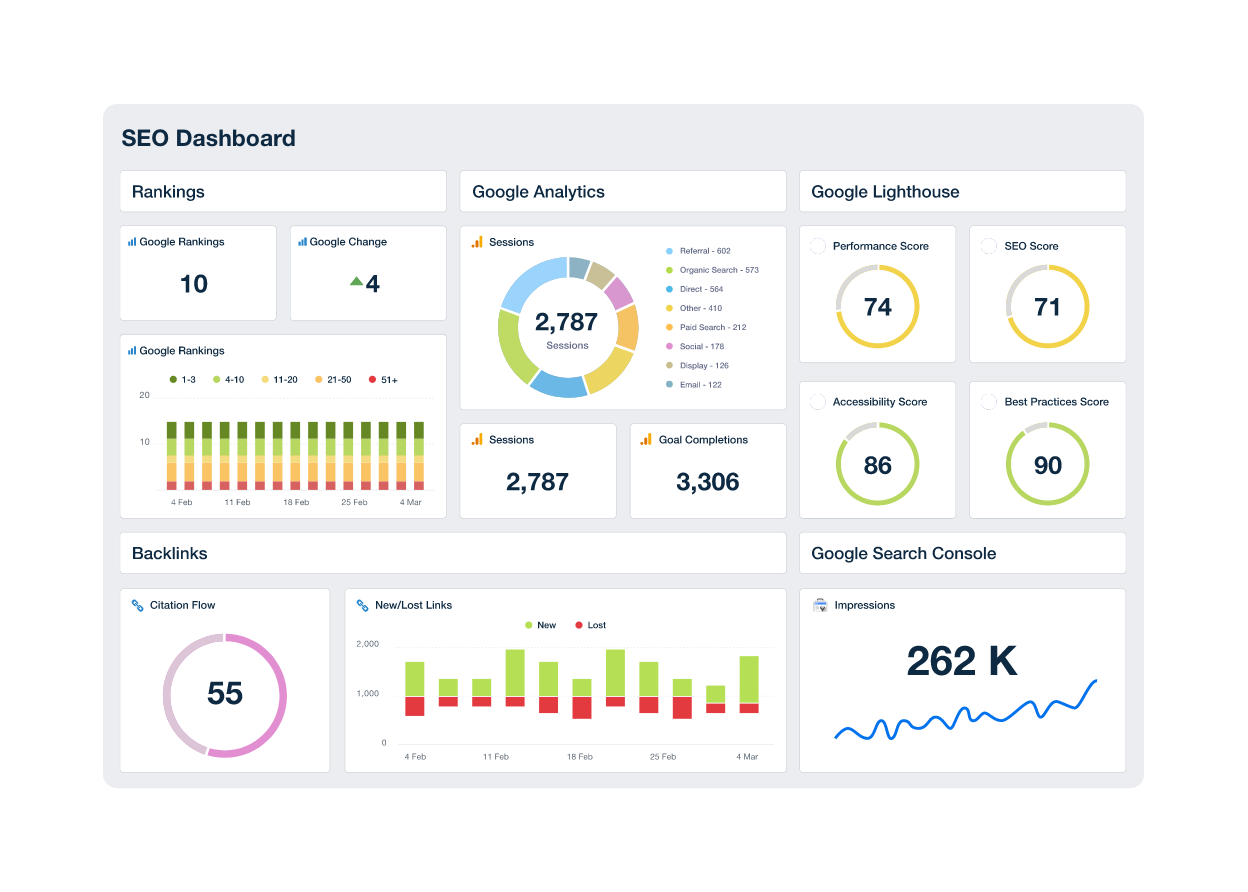
Build customizable digital marketing dashboards in as little as 11 seconds, with AgencyAnalytics! Sign up for your free 14-day trial today.
Key features of effective marketing dashboards
The best marketing dashboards help you optimize performance across all channels, simplifying complex data, providing detailed campaign metrics, and supporting automated reports that save time. They're powerful enough to provide actionable insights but flexible enough to work with different data dashboards–whether you’re managing a high data volume across multiple channels or just want to focus on a few key KPIs for a specific target audience.
From dashboards that monitor ad spend and conversions to ones that provide high-level overviews of lead generation or website traffic, the best marketing dashboard examples all have one thing in common: they make it easier to understand performance and take meaningful action.
Data accuracy and relevance
One of the most significant benefits of using marketing KPI dashboards is the ability to track metrics and data live. This real-time tracking offers a clear view of a client’s marketing efforts, so you can quickly spot what’s working or where you might need to pivot.
When you’re pulling from multiple data sources, it’s important to ensure data quality. An analytics dashboard eliminates the need to wait for end-of-month reports; instead, detailed metrics are updated automatically, offering a snapshot of how campaigns are performing at any given moment.

Customization and flexibility
When each client is different, with their own goals and priorities, a one-size-fits-all dashboard tool just doesn’t cut it.
The best dashboard enables custom KPI tracking and display, whether that’s sales growth, lead quality, website engagement, or return on ad spend, so your clients see exactly what matters to them.
When you take the time to create a custom dashboard, it shows your clients that you understand their business and are focused on the outcomes that drive their success.
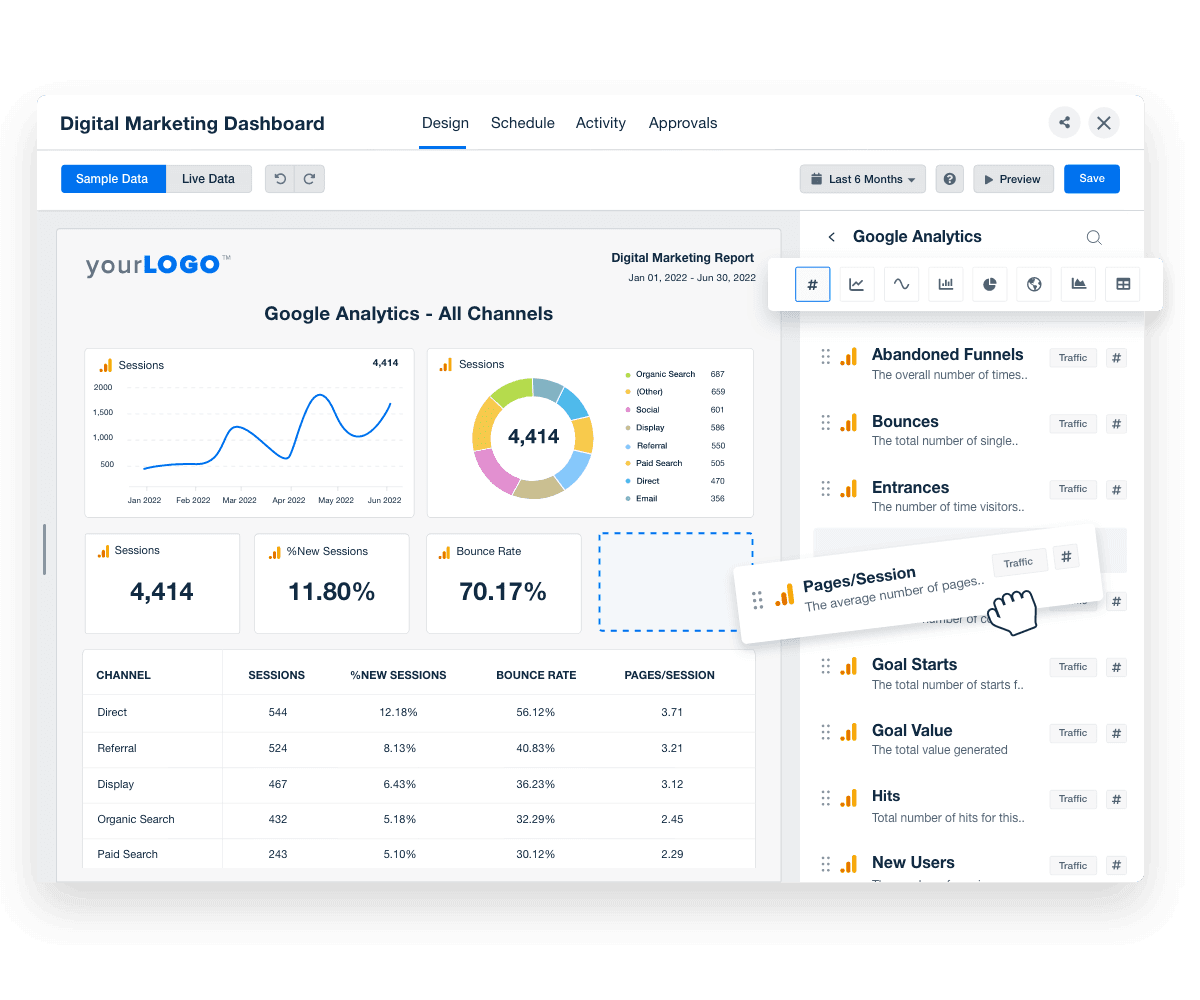
With more than 80 integrations and dozens of prebuilt templates, AgencyAnalytics makes dashboard creation a breeze. Start your free 14-day trial today.
Usability and accessibility
A well-designed dashboard is intuitive, even for non-technical users, giving clients a clear view of their marketing performance without requiring a deep dive into spreadsheets or analytics tools.
With features like custom permissions, you can control exactly what each client sees. Maybe a client only needs to view their social campaign performance, not the entire cross-channel strategy.

The easier you make it for clients to stay informed, the more confident they’ll feel in your partnership, and the more trust you’ll build along the way.
Collecting critical data all in one spot is amazing and has bought us time back. When you are tracking SEO, PPC, Social Media and email marketing campaigns it can be time consuming. This is why having a template and dashboard that efficiently does it all is a game changer.
Justin Hual, Co-Founder and COO, HIP Creative
Step-by-step guide to building a client dashboard
The best part about building a client dashboard? You get full control over how it looks, what it tracks, and how it supports your client’s goals. Whether you're using a marketing dashboard template or starting from scratch, the process is all about connecting data from multiple platforms and turning it into valuable insights your clients can actually use.
From SEO and lead generation dashboards to content marketing and social media dashboards, there are no shortage of options. No matter what you choose, it should be tailored to your client’s goals, easy to navigate, and focused on delivering clear, actionable insights.
In this next section, we'll show you how to create a dashboard that simplifies reporting, strengthens client relationships, and shows the full impact of your marketing efforts.
1. Establish goals
If you haven't clarified your clients' marketing goals, you might be wasting time on marketing campaigns that don’t align with a real business strategy. Reports feel disconnected, customer engagement drops, and clients question the results.
The solution? Make sure that key performance indicators (KPIs) are aligned with your client’s business goals.
When we begin working with a client, we always make sure we understand their business goals first. This can sometimes be tough, especially if the goal is to ‘increase revenue’ or ‘get new clients.’ It’s important to get really clear and specific so that everyone is on the same page about what success looks like with no assumptions.
Kerrie Luginbill, Chief Strategy Officer and Partner, OTM
For example, if your client wants to grow their customer base profitably, you may want to track customer acquisition cost (CAC), revenue metrics, and return on ad spend (ROAS). If their focus is on building brand awareness, engagement metrics like impressions, click-through rates, and social shares may be more relevant.
By tying every metric back to a specific business objective, your detailed dashboards display critical metrics that are not only informative but genuinely meaningful to your clients.
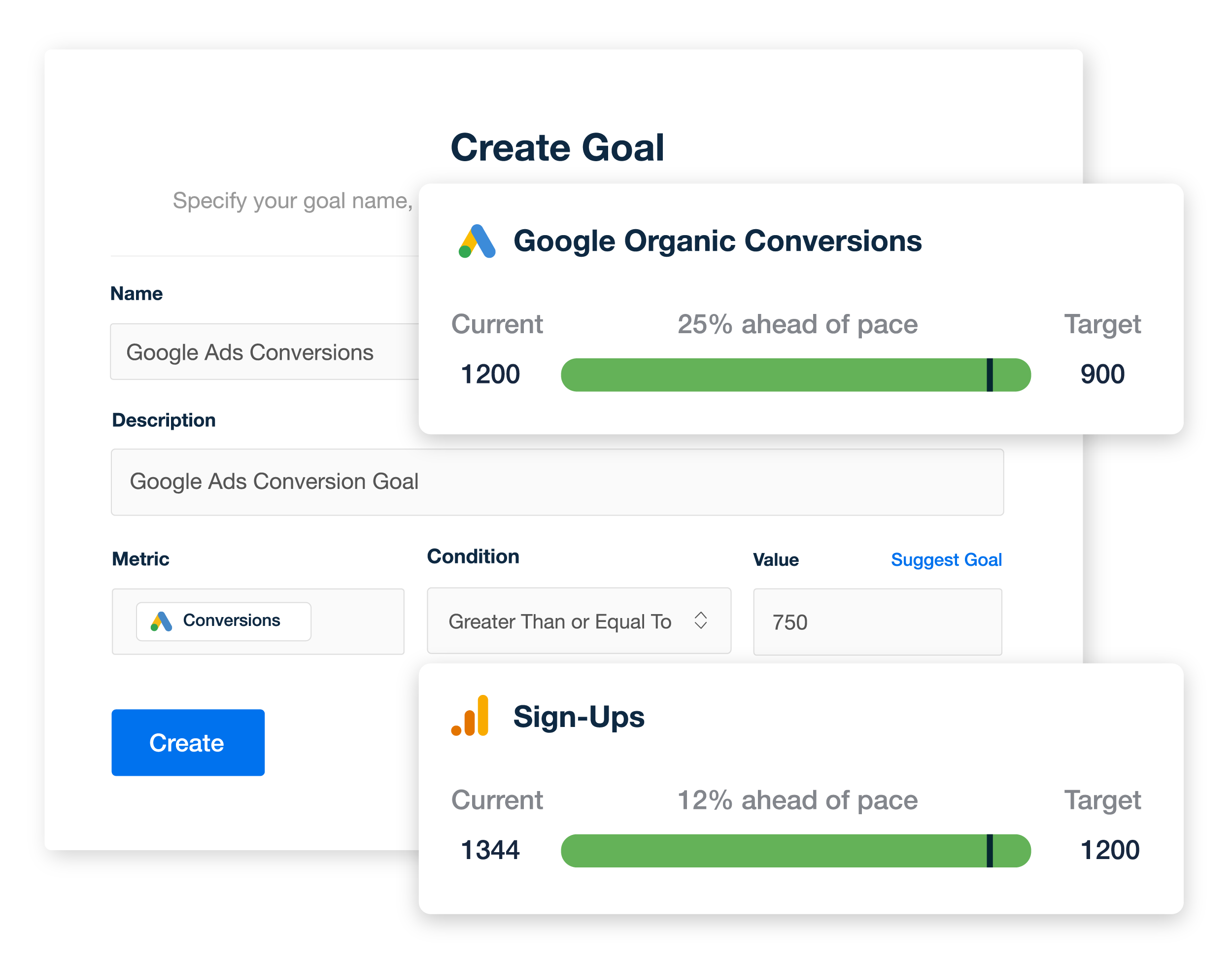
Create custom goals for your client marketing dashboards with AgencyAnalytics! Sign up now for a 14-day free trial.
2. Use a template, start from scratch, or create a Smart Dashboard
Creating a digital marketing dashboard for your clients doesn’t require reinventing the wheel.
With AgencyAnalytics, leverage pre-built dashboard templates or clone existing dashboards for new clients. This saves you time while maintaining consistency.
For even further time savings, Smart Dashboards allow you to whip up a client marketing dashboard in just 11 seconds, based on the top metrics from each integration you add.
Prefer full customization? Start from scratch and tailor every widget to your client’s specific goals. Build a smart dashboard that dynamically adjusts to different campaigns, channels, or KPIs, giving each client a personalized view of their marketing performance without adding tasks to your to do list.
3. Choose the metrics that matter
Focus on the data that drives results by selecting KPIs that align with your clients’ goals. With access to data from over 7,000 platform integrations–like Google Analytics, Google Ads, social media channels, SEO tools, and more–it’s easy to build dashboards that reflect each client’s unique priorities.
Take it a step further by creating custom metrics tailored to your clients’ specific marketing objectives. Whether it's tracking ROI, engagement, or lead generation quality, pull the data directly into a client dashboard, highlighting the real impact of your marketing efforts.
4. Set metric alerts and anomaly detection
By proactively monitoring key metrics, you catch unexpected changes–like a sudden drop in conversions or a spike in ad spend–before they snowball into bigger problems.
This is where predictive and prescriptive analytics come in. Predictive analytics helps you forecast what’s likely to happen next based on trends and historical data, while prescriptive analytics goes a step further by recommending the best actions to take in response.
Together, they turn raw data into strategic insights, so you’re not just reacting to changes, but making data-driven decisions to actively optimize campaigns before issues arise.
The AgencyAnalytics Anomaly Detection tool automatically highlights deviations in your clients’ data as they happen. Quickly understand unexpected performance shifts to optimize your marketing strategies without the extra analysis.
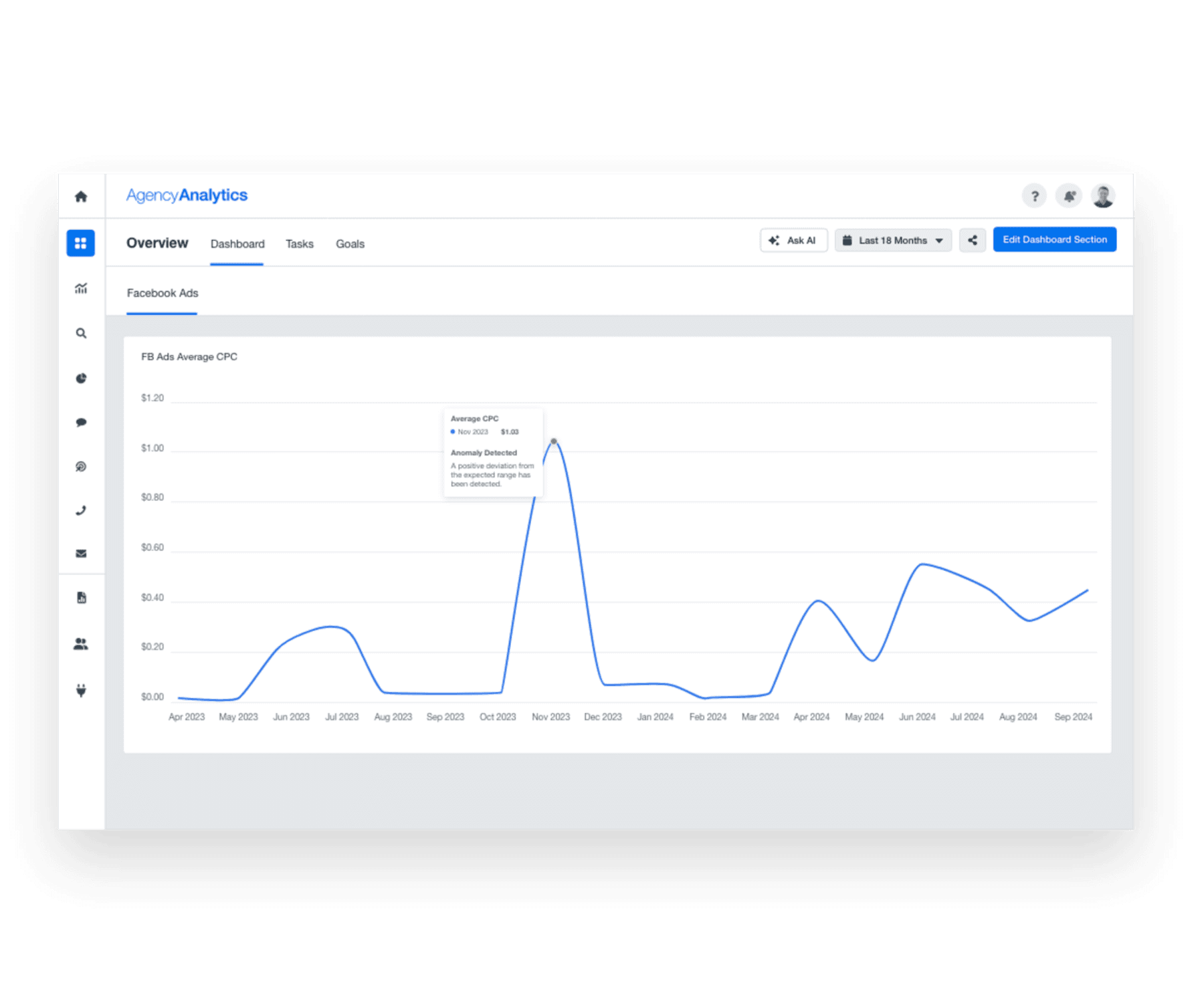
5. Set custom permissions
Build trust and transparency by giving clients their own login to live marketing dashboards with real-time, read-only access to the metrics that matter most. With custom permissions, you decide exactly what each user sees. For example, a local franchisee might only need access to their regional ad performance, while the national marketing manager sees all campaigns across locations.
You can also create staff accounts with permissions tailored to their roles. Assign a PPC specialist to just the Google Ads data for specific clients, or give an account manager access to SEO and social metrics across their entire business. Keep your marketing team focused and your data secure while removing the risk of someone accidentally making changes to a client’s dashboard or seeing sensitive info they shouldn’t.
AgencyAnalytics makes it easy for us to share campaign performance with our clients on a weekly and monthly cadence. We normally create a dashboard that features the primary KPIs for each channel we are managing on behalf of our clients and we share "client access" with them. They love that they are able to dive deep into the analytics on their own without needing our input each time.
Bryan Lozano, Vice President of Operations, Ad-Apt
Best practices for dashboard design and implementation
White label
A well-designed marketing dashboard is a reflection of your agency’s professionalism, strategy, and value. While the goal is to deliver insights that help your clients reach their business goals, that doesn’t mean dashboard design should be an afterthought.
White label dashboard tools allow you to fully brand the experience using your logo, colors, and custom domain to create a seamless, professional client interface. This reinforces your agency’s identity, builds trust, and positions your team as a strategic partner rather than just a service provider.
Agency tip: Pair white labeling with consistent formatting and a clear visual hierarchy so that your dashboards aren’t just on brand, but easy to understand and act on.
Choose data visualizations
The right chart or graph turns raw data into actionable insights, transforming abstract numbers into clear, context-driven business intelligence.
Visual elements help clients quickly grasp performance trends, spot issues, and understand what’s working without getting lost in rows of data.
Choose visualizations that match the message you're trying to convey. For example:
Line charts to show progress over time
Bar charts to compare performance across campaigns or channels
Pie charts for showing proportions, not detailed breakdowns
Tables when exact numbers matter or to list top-performing assets
Agency tip: Keep it simple and purposeful. Avoid clutter, label clearly, and highlight the metrics that directly connect to your client’s goals.
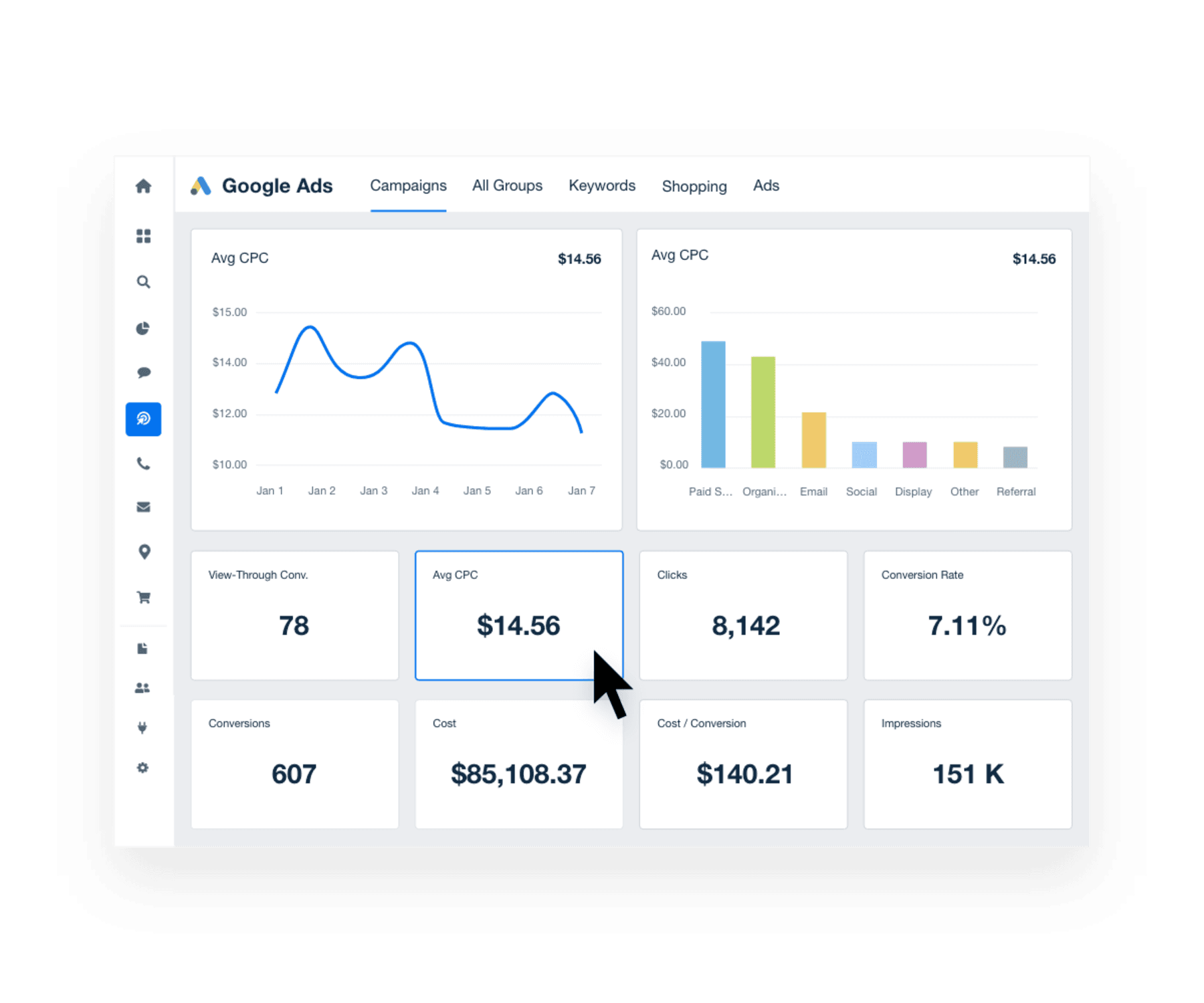
Give your clients instant clarity with a custom marketing dashboard. Use AgencyAnalytics to create visual, easy-to-understand reports that highlight key metrics, track progress, and prove your impact. Start your free 14-day trial today.
Include goals and annotations
Upgrade your dashboards by incorporating clear goals and contextual annotations. Setting measurable targets alongside your key metrics helps clients understand whether performance is on track and what success looks like.
Annotations provide valuable context–such as campaign launches, seasonality, or external events–that explain sudden changes or trends in the data. This storytelling element turns numbers into narratives, helping clients connect the dots and make informed decisions.
For example, if a client’s monthly sales dipped in June, an annotation noting a website redesign launch or a competitor’s major promotion can clarify the cause. Similarly, setting a goal to increase email open rates by 5% gives both you and your client a clear benchmark to measure progress against.
By combining goals and annotations, your dashboards become strategic guides that drive action and keep everyone on track towards shared objectives.
Common mistakes to avoid
Overcomplicating dashboards with unnecessary features: Adding every available widget or metric will overwhelm clients and dilute the focus. Stick to what truly matters for their goals.
Focusing solely on numbers and neglecting visuals: Raw marketing data alone can be confusing. Use clear, well-designed visualizations to make insights easier to grasp.
Forgetting to provide context: Numbers don’t tell the full story on their own. Include annotations, goals, or explanations so clients understand why metrics have changed.
Creating dashboards that don’t evolve with your clients: Marketing strategies and priorities shift over time. Regularly update dashboards to reflect new goals, campaigns, or channels.
Ignoring user access and permissions: Not setting proper access controls can lead to confusion or accidental data exposure. Tailor permissions to each user’s role and needs.
Using inconsistent formatting or terminology: Inconsistent labels, colors, or data formats will confuse clients and reduce trust. Keep dashboards uniform and easy to navigate.
Neglecting mobile responsiveness: Many clients review dashboards on phones or tablets. Ensure your dashboards are accessible and functional across devices.
Avoiding these common pitfalls ensures your dashboards remain clear, relevant, and a powerful tool for driving client success.
Smarter dashboards, stronger client relationships
Effective marketing dashboards go beyond building reports–they transform data into clear insights while facilitating strategic alignment and transparent communication.
By aligning KPIs with client goals, choosing the right data visualizations, adding meaningful goals and annotations, and setting custom permissions, you create dashboards that deliver real value.
Avoid common mistakes like overcomplication, lack of context, and keep things flexible so your dashboards evolve alongside your clients’ needs.
Actionable takeaways:
Start every dashboard by clearly defining your client’s business goals and aligning metrics accordingly.
Use visual storytelling to make complex data easy to understand and actionable.
Incorporate goals and annotations to provide context and guide decision-making.
Set granular user permissions to build trust and protect sensitive information.
Regularly review and update dashboards to keep them relevant and impactful.
By following these best practices, you’ll not only impress your clients but also deepen relationships and demonstrate your agency’s strategic value.
Streamline your agency’s reporting and get back billable hours. Try the client reporting tool used by over 7,000 agencies and counting–sign up for your free 14-day trial today.

Written by
Anya Leibovitch is a B2B SaaS content marketing specialist. She partners with tech companies to design and execute their content marketing strategy. A writer first and foremost, she harnesses the power of storytelling to build and strengthen relationships between companies and the clients they serve.
Read more posts by Anya LeibovitchSee how 7,000+ marketing agencies help clients win
Free 14-day trial. No credit card required.





